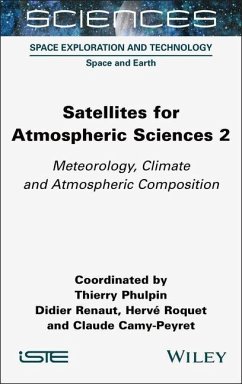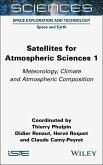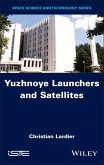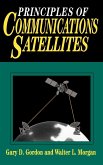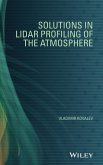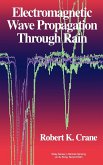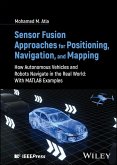Satellites for Atmospheric Sciences 2
Meteorology, Climate and Atmospheric Composition
Herausgeber: Phulpin, Thierry; Camy-Peyret, Claude; Roquet, Herve; Renaut, Didier
Satellites for Atmospheric Sciences 2
Meteorology, Climate and Atmospheric Composition
Herausgeber: Phulpin, Thierry; Camy-Peyret, Claude; Roquet, Herve; Renaut, Didier
- Gebundenes Buch
- Merkliste
- Auf die Merkliste
- Bewerten Bewerten
- Teilen
- Produkt teilen
- Produkterinnerung
- Produkterinnerung
How can atmospheric variables such as temperature, wind, rain and ozone be measured by satellites? How are these measurements taken and what has been learned since the first measurements in the 1970s? What data are currently available and what data are expected in the future? The second volume of this encyclopedic book presents each field of application - meteorology, atmospheric composition and climate - with its main aims as well as the specific areas which can be addressed through the use of satellite remote sensing. This book presents the satellite products used for operational purposes as…mehr
Andere Kunden interessierten sich auch für
![Satellites for Atmospheric Sciences 1 Satellites for Atmospheric Sciences 1]() Satellites for Atmospheric Sciences 1173,99 €
Satellites for Atmospheric Sciences 1173,99 €![Yuzhnoye Launchers and Satellites Yuzhnoye Launchers and Satellites]() Christian LardierYuzhnoye Launchers and Satellites158,99 €
Christian LardierYuzhnoye Launchers and Satellites158,99 €![Principles of Communications Satellites Principles of Communications Satellites]() Gary D GordonPrinciples of Communications Satellites251,99 €
Gary D GordonPrinciples of Communications Satellites251,99 €![Solutions in Lidar Profiling of the Atmosphere Solutions in Lidar Profiling of the Atmosphere]() Vladimir A KovalevSolutions in Lidar Profiling of the Atmosphere152,99 €
Vladimir A KovalevSolutions in Lidar Profiling of the Atmosphere152,99 €![Optimization in Engineering Sciences Optimization in Engineering Sciences]() Dan StefanoiuOptimization in Engineering Sciences218,99 €
Dan StefanoiuOptimization in Engineering Sciences218,99 €![Electromagnetic Wave Propagation Through Rain Electromagnetic Wave Propagation Through Rain]() Robert K CraneElectromagnetic Wave Propagation Through Rain232,99 €
Robert K CraneElectromagnetic Wave Propagation Through Rain232,99 €![Sensor Fusion Approaches for Positioning, Navigation, and Mapping Sensor Fusion Approaches for Positioning, Navigation, and Mapping]() Mohamed M AtiaSensor Fusion Approaches for Positioning, Navigation, and Mapping151,99 €
Mohamed M AtiaSensor Fusion Approaches for Positioning, Navigation, and Mapping151,99 €-
-
-
How can atmospheric variables such as temperature, wind, rain and ozone be measured by satellites? How are these measurements taken and what has been learned since the first measurements in the 1970s? What data are currently available and what data are expected in the future? The second volume of this encyclopedic book presents each field of application - meteorology, atmospheric composition and climate - with its main aims as well as the specific areas which can be addressed through the use of satellite remote sensing. This book presents the satellite products used for operational purposes as well as those that allow for the advancement of scientific knowledge. The instruments that are at their origin are described, as well as the processing, delivery times and the knowledge they provide. This book is completed by a glossary and appendices with a list of supporting instruments already in use.
Hinweis: Dieser Artikel kann nur an eine deutsche Lieferadresse ausgeliefert werden.
Hinweis: Dieser Artikel kann nur an eine deutsche Lieferadresse ausgeliefert werden.
Produktdetails
- Produktdetails
- Verlag: Wiley
- Seitenzahl: 416
- Erscheinungstermin: 24. Januar 2024
- Englisch
- Abmessung: 234mm x 156mm x 24mm
- Gewicht: 753g
- ISBN-13: 9781789451412
- ISBN-10: 1789451418
- Artikelnr.: 69677549
- Herstellerkennzeichnung
- Libri GmbH
- Europaallee 1
- 36244 Bad Hersfeld
- gpsr@libri.de
- Verlag: Wiley
- Seitenzahl: 416
- Erscheinungstermin: 24. Januar 2024
- Englisch
- Abmessung: 234mm x 156mm x 24mm
- Gewicht: 753g
- ISBN-13: 9781789451412
- ISBN-10: 1789451418
- Artikelnr.: 69677549
- Herstellerkennzeichnung
- Libri GmbH
- Europaallee 1
- 36244 Bad Hersfeld
- gpsr@libri.de
Thierry Phulpin is a senior expert in space missions for atmospheric sciences. He has been a researcher at Météo-France, Lannion, then program scientist on missions for meteorology (IASI, IASI-NG) and air quality (TRAQ, 3MI) at the CNES, Toulouse. Didier Renaut is a meteorological engineer, now retired. He made his career at Météo-France, Paris, then at the CNES, Paris, where he was in charge of meteorological and climate programs. He has also worked in the field of scientific publishing. Hervé Roquet is a meteorological engineer at Météo-France. After several years at the Space Meteorology Center of Météo-France in Lannion, he joined the Higher Education and Research Department of Météo-France in Saint-Mandé in 2017, where he is the deputy director. Claude Camy-Peyret is currently emeritus scientist at Institut Pierre Simon Laplace, Paris. He is also a retired research director at the CNRS, Paris. From 1996 to 2008 he was the head of LPMAA at Sorbonne Université, Paris.
Acknowledgments xiii
List of Acronyms xv
Introduction xxxiii
Thierry PHULPIN
Part 1 Meteorology 1
Introduction to Part 1 3
Hervé ROQUET
Chapter 1 Operational Sounding of Thermodynamic Variables in the Atmosphere
9
Thomas AUGUST
1.1 Introduction 9
1.2 Operational use of TIR and MW sounders 11
1.2.1 Satisfying ever-more demanding users 11
1.2.2 Clouds: an obstacle to sounding and a very useful geophysical product
17
1.2.3 Demonstrating and maintaining product quality 19
1.2.4 Different operational algorithmic strategies 22
1.2.5 Application perspectives 25
1.3 Acknowledgments 26
1.4 References 27
Chapter 2 Wind Observations 31
Régis BORDE and Jean PAILLEUX
2.1 Introduction 31
2.2 AMVs 34
2.2.1 Extraction of AMVs 34
2.2.2 Current production and outlook 35
2.3 3D winds derived from hyperspectral sounders 37
2.4 Measuring wind from space using Doppler lidar 39
2.4.1 Introduction 39
2.4.2 Measurements from ALADIN lidar onboard Aeolus 40
2.4.3 Culmination of a long process 41
2.4.4 Situation in 2022 and outlook 42
2.5 References 43
Chapter 3 Surface Variables 47
Jean-François MAHFOUF
3.1 Observation of the Earth's surface from space 47
3.2 Energy balances at the surface and at the top of the atmosphere 49
3.3 Ocean surfaces 50
3.3.1 Surface temperature 50
3.3.2 Surface wind 52
3.3.3 Sea ice 54
3.4 Continental surfaces 56
3.4.1 Surface temperature 56
3.4.2 Water content of soil 57
3.4.3 Surface albedo 61
3.4.4 Vegetation properties 62
3.5 Snow-covered surfaces 64
3.5.1 Spatial coverage and albedo 64
3.5.2 Equivalent water content 65
3.6 Expected changes 65
3.7 References 66
Chapter 4 The Assimilation of Satellite Data in Numerical Weather
Prediction Systems 69
Bill BELL, Jean-Noël THÉPAUT and John EYRE
4.1 Introduction 69
4.2 Early meteorological satellites 71
4.3 Assimilation of satellite soundings 1970-2000 71
4.3.1 Early sounding instruments 71
4.3.2 Assimilation experience: 1970s 73
4.3.3 Assimilation experience: early 1980s 73
4.3.4 Problems arising in the late 1980s 74
4.4 Relevant aspects of data assimilation theory 75
4.5 The modern era (2000 to present) 77
4.5.1 Assimilation strategies 77
4.5.2 Advanced infrared sounders 79
4.5.3 Microwave sounders and imagers 81
4.5.4 Radiative transfer modeling 83
4.5.5 Observation uncertainties 83
4.5.6 Atmospheric motion vectors (AMVs) 84
4.5.7 Scatterometers 86
4.5.8 Radio occultation observations 87
4.5.9 Impacts 89
4.5.10 Reanalyses 91
4.6 Summary and conclusion 91
4.7 References 92
Chapter 5 Nowcasting 97
Thibaut MONTMERLE
5.1 Introduction 97
5.2 Satellite data for nowcasting 99
5.2.1 Polar-orbiting satellites 99
5.2.2 Geostationary satellites 100
5.3 Observed phenomena 104
5.3.1 Air mass instability 104
5.3.2 Convective systems 104
5.3.3 Characteristics of clouds 108
5.3.4 Hydrometeors 109
5.3.5 Wind 110
5.4 Nowcasting of detected phenomena 111
5.4.1 Method based on the tracking of structures 111
5.4.2 Method based on image extrapolation 112
5.4.3 Method based on artificial intelligence 112
5.4.4 Use of numerical forecasting 114
5.4.5 OBS-NWP fusion 115
5.4.6 Probabilistic forecast 115
5.5 Perspectives 116
5.6 References 116
Chapter 6 Observation and Monitoring of Tropical Cyclones from Space 119
Frank ROUX
6.1 Introduction 119
6.2 Visible and infrared imagery 120
6.3 Microwave imaging 122
6.4 Microwave sounding 125
6.5 Surface wind measurements 126
viii Satellites for Atmospheric Sciences 2
6.6 Ocean parameters 130
6.7 Climatology of cyclones 131
6.8 Conclusion 132
6.9 References 133
Part 2 Atmospheric Composition 137
Introduction to Part 2 Air Composition and the Contribution from Satellite
Observations 139
Thierry PHULPIN and Claude CAMY-PEYRET
Chapter 7 Reactive Tropospheric Chemistry 143
Sarah SAFIEDDINE and Camille VIATTE
7.1 Introduction 143
7.2 Methane 144
7.3 Reactive organic species 144
7.3.1 Isoprene 146
7.3.2 Other non-methane volatile organic compounds 146
7.4 Reactive inorganic species 148
7.5 Conclusion 150
7.6 Acknowledgment 150
7.7 References 150
Chapter 8 Major Pollutants: Ozone and Fine Particulate Matter 153
Juan CUESTA and Gaëlle DUFOUR
8.1 Introduction 153
8.2 Tropospheric ozone 154
8.2.1 Beginnings of satellite-based tropospheric ozone observations 154
8.2.2 Current capabilities for tropospheric ozone monitoring 155
8.2.3 Multi-wavelength synergy for ozone pollution monitoring 157
8.3 Pollution aerosols 158
8.3.1 Optical thickness of pollution aerosols 159
8.3.2 Altitude of pollution aerosols 161
8.4 References 163
Chapter 9 Desert Dust 167
Juan CUESTA
9.1 Introduction 167
9.2 Qualitative satellite detection of desert dust 168
9.3 Satellite observation of the optical depth of desert dust 170
9.4 Vertical profiles of desert dust by spaceborne lidar 171
9.5 3D distribution of desert dust by infrared spectrometer 173
9.6 Conclusion 175
9.7 References 176
Chapter 10 Species Emitted by Fires 179
Camille VIATTE and Pasquale SELLITTO
10.1 Introduction 179
10.2 Biomass burning gases 181
10.2.1 Greenhouses gases 181
10.2.2 Carbon monoxide (CO) 181
10.2.3 Volatile organic compounds (VOCs) 182
10.2.4 Ammonia (NH3) 183
10.2.5 Nitrous acid (HONO) 183
10.3 Biomass burning aerosols 183
10.3.1 AOD observations with nadir-viewing instruments 183
10.3.2 Extinction observations with limb-viewing instruments 184
10.3.3 Lidar profiles observations 184
10.4 Fire detection systems from space 184
10.5 Conclusion 185
10.6 Acknowledgments 185
10.7 References 185
Chapter 11 Stratospheric Chemistry 189
Claude CAMY-PEYRET and Sarah SAFIEDDINE
11.1 Introduction 189
11.2 Stratospheric ozone chemistry 189
11.2.1 Polar ozone depletion 190
11.2.2 Antarctic ozone distribution 192
11.2.3 Arctic ozone distribution 193
11.3 Stratospheric chemistry of other species 193
11.3.1 Chemistry of the stratosphere and models 194
11.3.2 Radical processes and cycles for the major families 196
11.3.3 The example of methane in the stratosphere 197
11.4 Satellite measurements of trace species in the stratosphere 198
11.5 Conclusion 200
11.6 Acknowledgments 200
11.7 References 200
Part 3 Atmosphere and climate 203
Introduction to Part 3 Atmosphere and Climate and the Contribution of Space
205
Paul POLI
Chapter 12 Climate Monitoring 209
Paul POLI and Jörg SCHULZ
12.1 General concepts about the climate 209
12.1.1 What is climate? 209
12.1.2 Is climate limited to atmospheric phenomena? 211
12.1.3 A question for Nobel Prize laureates: is the climate stable? 213
12.2 From space-based measurements to climate products 215
12.2.1 Sensing the environment 215
12.2.2 The role of space-based observations 217
12.2.3 The concept of essential climate variables 218
12.2.4 Observation-based products 220
12.2.5 Model-assisted climate products 221
12.3 Climate data records and uncertainty estimates 223
12.3.1 Why reprocessing? 223
12.3.2 Calibration 224
12.3.3 Uncertainty 226
12.4 The usage of climate data records in science and services 228
12.5 Looking ahead 230
12.6 References 231
12.7 References of the data sources cited in Figure 12.1 232
Chapter 13 Anthropogenic Greenhouse Gases: CO2 and CH4 235
Cyril CREVOISIER
13.1 Monitoring anthropogenic greenhouse gases 236
13.1.1 Biogeochemical cycles 236
13.1.2 Determination of gas sources and sinks 236
13.1.3 The global observation network 237
13.2 Contribution of spatial observation of greenhouse gases 238
13.2.1 Specificities of greenhouse gas observation 238
13.2.2 Particularly rich spatial programming 241
13.3 Measurement techniques 242
13.3.1 Passive observations in the infrared range 243
13.3.2 Passive observations by solar reflection 245
13.3.3 Passive observations by solar occultation 247
13.3.4 Active observations using lidar 247
13.4 From radiation measurement to gas flux at the surface 248
13.4.1 From radiation measurement to gas concentrations 248
13.4.2 From concentration to fluxes 250
13.4.3 Main limitations 251
13.5 Challenges for the future 252
13.5.1 Towards the observation of anthropogenic emissions by spatial
imagery 253
13.5.2 Reducing spatio-temporal sampling biases 253
13.5.3 Towards an operational greenhouse gas monitoring service 254
13.6 References 255
Chapter 14 Clouds and Water Vapor 259
Hélène BROGNIEZ, Laurence PICON and Dominique BOUNIOL
14.1 Atmospheric water cycle and climate 259
14.2 Observations of water vapor 260
14.2.1 Passive sensors 263
14.2.2 Active sensors 265
14.2.3 Homogenization and intercomparison 266
14.3 Observation of cloud properties 267
14.3.1 Observations using passive instruments 270
14.3.2 Observations using active instruments 273
14.3.3 Multi-instrument synergy for the establishment of cloud
climatologies 277
14.4 References 282
Chapter 15 Precipitation 287
Vincenzo LEVIZZANI and Christopher KIDD
15.1 Need for global precipitation measurements 287
15.2 Satellite observation of rainfall 289
15.2.1 Visible/Infrared 290
15.2.2 Passive microwave 291
15.2.3 Radar 294
15.2.4 Merged products 295
15.3 Observation of solid precipitation 298
15.4 Precipitation and the Earth water cycle 300
15.5 References 303
Appendices 307
Appendix 1 309
Claude CAMY-PEYRET
Appendix 2 317
Claude CAMY-PEYRET
Appendix 3 327
Appendix 4 341
Glossary 347
List of Authors 361
Index 365
Summary of Volume 1 369
List of Acronyms xv
Introduction xxxiii
Thierry PHULPIN
Part 1 Meteorology 1
Introduction to Part 1 3
Hervé ROQUET
Chapter 1 Operational Sounding of Thermodynamic Variables in the Atmosphere
9
Thomas AUGUST
1.1 Introduction 9
1.2 Operational use of TIR and MW sounders 11
1.2.1 Satisfying ever-more demanding users 11
1.2.2 Clouds: an obstacle to sounding and a very useful geophysical product
17
1.2.3 Demonstrating and maintaining product quality 19
1.2.4 Different operational algorithmic strategies 22
1.2.5 Application perspectives 25
1.3 Acknowledgments 26
1.4 References 27
Chapter 2 Wind Observations 31
Régis BORDE and Jean PAILLEUX
2.1 Introduction 31
2.2 AMVs 34
2.2.1 Extraction of AMVs 34
2.2.2 Current production and outlook 35
2.3 3D winds derived from hyperspectral sounders 37
2.4 Measuring wind from space using Doppler lidar 39
2.4.1 Introduction 39
2.4.2 Measurements from ALADIN lidar onboard Aeolus 40
2.4.3 Culmination of a long process 41
2.4.4 Situation in 2022 and outlook 42
2.5 References 43
Chapter 3 Surface Variables 47
Jean-François MAHFOUF
3.1 Observation of the Earth's surface from space 47
3.2 Energy balances at the surface and at the top of the atmosphere 49
3.3 Ocean surfaces 50
3.3.1 Surface temperature 50
3.3.2 Surface wind 52
3.3.3 Sea ice 54
3.4 Continental surfaces 56
3.4.1 Surface temperature 56
3.4.2 Water content of soil 57
3.4.3 Surface albedo 61
3.4.4 Vegetation properties 62
3.5 Snow-covered surfaces 64
3.5.1 Spatial coverage and albedo 64
3.5.2 Equivalent water content 65
3.6 Expected changes 65
3.7 References 66
Chapter 4 The Assimilation of Satellite Data in Numerical Weather
Prediction Systems 69
Bill BELL, Jean-Noël THÉPAUT and John EYRE
4.1 Introduction 69
4.2 Early meteorological satellites 71
4.3 Assimilation of satellite soundings 1970-2000 71
4.3.1 Early sounding instruments 71
4.3.2 Assimilation experience: 1970s 73
4.3.3 Assimilation experience: early 1980s 73
4.3.4 Problems arising in the late 1980s 74
4.4 Relevant aspects of data assimilation theory 75
4.5 The modern era (2000 to present) 77
4.5.1 Assimilation strategies 77
4.5.2 Advanced infrared sounders 79
4.5.3 Microwave sounders and imagers 81
4.5.4 Radiative transfer modeling 83
4.5.5 Observation uncertainties 83
4.5.6 Atmospheric motion vectors (AMVs) 84
4.5.7 Scatterometers 86
4.5.8 Radio occultation observations 87
4.5.9 Impacts 89
4.5.10 Reanalyses 91
4.6 Summary and conclusion 91
4.7 References 92
Chapter 5 Nowcasting 97
Thibaut MONTMERLE
5.1 Introduction 97
5.2 Satellite data for nowcasting 99
5.2.1 Polar-orbiting satellites 99
5.2.2 Geostationary satellites 100
5.3 Observed phenomena 104
5.3.1 Air mass instability 104
5.3.2 Convective systems 104
5.3.3 Characteristics of clouds 108
5.3.4 Hydrometeors 109
5.3.5 Wind 110
5.4 Nowcasting of detected phenomena 111
5.4.1 Method based on the tracking of structures 111
5.4.2 Method based on image extrapolation 112
5.4.3 Method based on artificial intelligence 112
5.4.4 Use of numerical forecasting 114
5.4.5 OBS-NWP fusion 115
5.4.6 Probabilistic forecast 115
5.5 Perspectives 116
5.6 References 116
Chapter 6 Observation and Monitoring of Tropical Cyclones from Space 119
Frank ROUX
6.1 Introduction 119
6.2 Visible and infrared imagery 120
6.3 Microwave imaging 122
6.4 Microwave sounding 125
6.5 Surface wind measurements 126
viii Satellites for Atmospheric Sciences 2
6.6 Ocean parameters 130
6.7 Climatology of cyclones 131
6.8 Conclusion 132
6.9 References 133
Part 2 Atmospheric Composition 137
Introduction to Part 2 Air Composition and the Contribution from Satellite
Observations 139
Thierry PHULPIN and Claude CAMY-PEYRET
Chapter 7 Reactive Tropospheric Chemistry 143
Sarah SAFIEDDINE and Camille VIATTE
7.1 Introduction 143
7.2 Methane 144
7.3 Reactive organic species 144
7.3.1 Isoprene 146
7.3.2 Other non-methane volatile organic compounds 146
7.4 Reactive inorganic species 148
7.5 Conclusion 150
7.6 Acknowledgment 150
7.7 References 150
Chapter 8 Major Pollutants: Ozone and Fine Particulate Matter 153
Juan CUESTA and Gaëlle DUFOUR
8.1 Introduction 153
8.2 Tropospheric ozone 154
8.2.1 Beginnings of satellite-based tropospheric ozone observations 154
8.2.2 Current capabilities for tropospheric ozone monitoring 155
8.2.3 Multi-wavelength synergy for ozone pollution monitoring 157
8.3 Pollution aerosols 158
8.3.1 Optical thickness of pollution aerosols 159
8.3.2 Altitude of pollution aerosols 161
8.4 References 163
Chapter 9 Desert Dust 167
Juan CUESTA
9.1 Introduction 167
9.2 Qualitative satellite detection of desert dust 168
9.3 Satellite observation of the optical depth of desert dust 170
9.4 Vertical profiles of desert dust by spaceborne lidar 171
9.5 3D distribution of desert dust by infrared spectrometer 173
9.6 Conclusion 175
9.7 References 176
Chapter 10 Species Emitted by Fires 179
Camille VIATTE and Pasquale SELLITTO
10.1 Introduction 179
10.2 Biomass burning gases 181
10.2.1 Greenhouses gases 181
10.2.2 Carbon monoxide (CO) 181
10.2.3 Volatile organic compounds (VOCs) 182
10.2.4 Ammonia (NH3) 183
10.2.5 Nitrous acid (HONO) 183
10.3 Biomass burning aerosols 183
10.3.1 AOD observations with nadir-viewing instruments 183
10.3.2 Extinction observations with limb-viewing instruments 184
10.3.3 Lidar profiles observations 184
10.4 Fire detection systems from space 184
10.5 Conclusion 185
10.6 Acknowledgments 185
10.7 References 185
Chapter 11 Stratospheric Chemistry 189
Claude CAMY-PEYRET and Sarah SAFIEDDINE
11.1 Introduction 189
11.2 Stratospheric ozone chemistry 189
11.2.1 Polar ozone depletion 190
11.2.2 Antarctic ozone distribution 192
11.2.3 Arctic ozone distribution 193
11.3 Stratospheric chemistry of other species 193
11.3.1 Chemistry of the stratosphere and models 194
11.3.2 Radical processes and cycles for the major families 196
11.3.3 The example of methane in the stratosphere 197
11.4 Satellite measurements of trace species in the stratosphere 198
11.5 Conclusion 200
11.6 Acknowledgments 200
11.7 References 200
Part 3 Atmosphere and climate 203
Introduction to Part 3 Atmosphere and Climate and the Contribution of Space
205
Paul POLI
Chapter 12 Climate Monitoring 209
Paul POLI and Jörg SCHULZ
12.1 General concepts about the climate 209
12.1.1 What is climate? 209
12.1.2 Is climate limited to atmospheric phenomena? 211
12.1.3 A question for Nobel Prize laureates: is the climate stable? 213
12.2 From space-based measurements to climate products 215
12.2.1 Sensing the environment 215
12.2.2 The role of space-based observations 217
12.2.3 The concept of essential climate variables 218
12.2.4 Observation-based products 220
12.2.5 Model-assisted climate products 221
12.3 Climate data records and uncertainty estimates 223
12.3.1 Why reprocessing? 223
12.3.2 Calibration 224
12.3.3 Uncertainty 226
12.4 The usage of climate data records in science and services 228
12.5 Looking ahead 230
12.6 References 231
12.7 References of the data sources cited in Figure 12.1 232
Chapter 13 Anthropogenic Greenhouse Gases: CO2 and CH4 235
Cyril CREVOISIER
13.1 Monitoring anthropogenic greenhouse gases 236
13.1.1 Biogeochemical cycles 236
13.1.2 Determination of gas sources and sinks 236
13.1.3 The global observation network 237
13.2 Contribution of spatial observation of greenhouse gases 238
13.2.1 Specificities of greenhouse gas observation 238
13.2.2 Particularly rich spatial programming 241
13.3 Measurement techniques 242
13.3.1 Passive observations in the infrared range 243
13.3.2 Passive observations by solar reflection 245
13.3.3 Passive observations by solar occultation 247
13.3.4 Active observations using lidar 247
13.4 From radiation measurement to gas flux at the surface 248
13.4.1 From radiation measurement to gas concentrations 248
13.4.2 From concentration to fluxes 250
13.4.3 Main limitations 251
13.5 Challenges for the future 252
13.5.1 Towards the observation of anthropogenic emissions by spatial
imagery 253
13.5.2 Reducing spatio-temporal sampling biases 253
13.5.3 Towards an operational greenhouse gas monitoring service 254
13.6 References 255
Chapter 14 Clouds and Water Vapor 259
Hélène BROGNIEZ, Laurence PICON and Dominique BOUNIOL
14.1 Atmospheric water cycle and climate 259
14.2 Observations of water vapor 260
14.2.1 Passive sensors 263
14.2.2 Active sensors 265
14.2.3 Homogenization and intercomparison 266
14.3 Observation of cloud properties 267
14.3.1 Observations using passive instruments 270
14.3.2 Observations using active instruments 273
14.3.3 Multi-instrument synergy for the establishment of cloud
climatologies 277
14.4 References 282
Chapter 15 Precipitation 287
Vincenzo LEVIZZANI and Christopher KIDD
15.1 Need for global precipitation measurements 287
15.2 Satellite observation of rainfall 289
15.2.1 Visible/Infrared 290
15.2.2 Passive microwave 291
15.2.3 Radar 294
15.2.4 Merged products 295
15.3 Observation of solid precipitation 298
15.4 Precipitation and the Earth water cycle 300
15.5 References 303
Appendices 307
Appendix 1 309
Claude CAMY-PEYRET
Appendix 2 317
Claude CAMY-PEYRET
Appendix 3 327
Appendix 4 341
Glossary 347
List of Authors 361
Index 365
Summary of Volume 1 369
Acknowledgments xiii
List of Acronyms xv
Introduction xxxiii
Thierry PHULPIN
Part 1 Meteorology 1
Introduction to Part 1 3
Hervé ROQUET
Chapter 1 Operational Sounding of Thermodynamic Variables in the Atmosphere
9
Thomas AUGUST
1.1 Introduction 9
1.2 Operational use of TIR and MW sounders 11
1.2.1 Satisfying ever-more demanding users 11
1.2.2 Clouds: an obstacle to sounding and a very useful geophysical product
17
1.2.3 Demonstrating and maintaining product quality 19
1.2.4 Different operational algorithmic strategies 22
1.2.5 Application perspectives 25
1.3 Acknowledgments 26
1.4 References 27
Chapter 2 Wind Observations 31
Régis BORDE and Jean PAILLEUX
2.1 Introduction 31
2.2 AMVs 34
2.2.1 Extraction of AMVs 34
2.2.2 Current production and outlook 35
2.3 3D winds derived from hyperspectral sounders 37
2.4 Measuring wind from space using Doppler lidar 39
2.4.1 Introduction 39
2.4.2 Measurements from ALADIN lidar onboard Aeolus 40
2.4.3 Culmination of a long process 41
2.4.4 Situation in 2022 and outlook 42
2.5 References 43
Chapter 3 Surface Variables 47
Jean-François MAHFOUF
3.1 Observation of the Earth's surface from space 47
3.2 Energy balances at the surface and at the top of the atmosphere 49
3.3 Ocean surfaces 50
3.3.1 Surface temperature 50
3.3.2 Surface wind 52
3.3.3 Sea ice 54
3.4 Continental surfaces 56
3.4.1 Surface temperature 56
3.4.2 Water content of soil 57
3.4.3 Surface albedo 61
3.4.4 Vegetation properties 62
3.5 Snow-covered surfaces 64
3.5.1 Spatial coverage and albedo 64
3.5.2 Equivalent water content 65
3.6 Expected changes 65
3.7 References 66
Chapter 4 The Assimilation of Satellite Data in Numerical Weather
Prediction Systems 69
Bill BELL, Jean-Noël THÉPAUT and John EYRE
4.1 Introduction 69
4.2 Early meteorological satellites 71
4.3 Assimilation of satellite soundings 1970-2000 71
4.3.1 Early sounding instruments 71
4.3.2 Assimilation experience: 1970s 73
4.3.3 Assimilation experience: early 1980s 73
4.3.4 Problems arising in the late 1980s 74
4.4 Relevant aspects of data assimilation theory 75
4.5 The modern era (2000 to present) 77
4.5.1 Assimilation strategies 77
4.5.2 Advanced infrared sounders 79
4.5.3 Microwave sounders and imagers 81
4.5.4 Radiative transfer modeling 83
4.5.5 Observation uncertainties 83
4.5.6 Atmospheric motion vectors (AMVs) 84
4.5.7 Scatterometers 86
4.5.8 Radio occultation observations 87
4.5.9 Impacts 89
4.5.10 Reanalyses 91
4.6 Summary and conclusion 91
4.7 References 92
Chapter 5 Nowcasting 97
Thibaut MONTMERLE
5.1 Introduction 97
5.2 Satellite data for nowcasting 99
5.2.1 Polar-orbiting satellites 99
5.2.2 Geostationary satellites 100
5.3 Observed phenomena 104
5.3.1 Air mass instability 104
5.3.2 Convective systems 104
5.3.3 Characteristics of clouds 108
5.3.4 Hydrometeors 109
5.3.5 Wind 110
5.4 Nowcasting of detected phenomena 111
5.4.1 Method based on the tracking of structures 111
5.4.2 Method based on image extrapolation 112
5.4.3 Method based on artificial intelligence 112
5.4.4 Use of numerical forecasting 114
5.4.5 OBS-NWP fusion 115
5.4.6 Probabilistic forecast 115
5.5 Perspectives 116
5.6 References 116
Chapter 6 Observation and Monitoring of Tropical Cyclones from Space 119
Frank ROUX
6.1 Introduction 119
6.2 Visible and infrared imagery 120
6.3 Microwave imaging 122
6.4 Microwave sounding 125
6.5 Surface wind measurements 126
viii Satellites for Atmospheric Sciences 2
6.6 Ocean parameters 130
6.7 Climatology of cyclones 131
6.8 Conclusion 132
6.9 References 133
Part 2 Atmospheric Composition 137
Introduction to Part 2 Air Composition and the Contribution from Satellite
Observations 139
Thierry PHULPIN and Claude CAMY-PEYRET
Chapter 7 Reactive Tropospheric Chemistry 143
Sarah SAFIEDDINE and Camille VIATTE
7.1 Introduction 143
7.2 Methane 144
7.3 Reactive organic species 144
7.3.1 Isoprene 146
7.3.2 Other non-methane volatile organic compounds 146
7.4 Reactive inorganic species 148
7.5 Conclusion 150
7.6 Acknowledgment 150
7.7 References 150
Chapter 8 Major Pollutants: Ozone and Fine Particulate Matter 153
Juan CUESTA and Gaëlle DUFOUR
8.1 Introduction 153
8.2 Tropospheric ozone 154
8.2.1 Beginnings of satellite-based tropospheric ozone observations 154
8.2.2 Current capabilities for tropospheric ozone monitoring 155
8.2.3 Multi-wavelength synergy for ozone pollution monitoring 157
8.3 Pollution aerosols 158
8.3.1 Optical thickness of pollution aerosols 159
8.3.2 Altitude of pollution aerosols 161
8.4 References 163
Chapter 9 Desert Dust 167
Juan CUESTA
9.1 Introduction 167
9.2 Qualitative satellite detection of desert dust 168
9.3 Satellite observation of the optical depth of desert dust 170
9.4 Vertical profiles of desert dust by spaceborne lidar 171
9.5 3D distribution of desert dust by infrared spectrometer 173
9.6 Conclusion 175
9.7 References 176
Chapter 10 Species Emitted by Fires 179
Camille VIATTE and Pasquale SELLITTO
10.1 Introduction 179
10.2 Biomass burning gases 181
10.2.1 Greenhouses gases 181
10.2.2 Carbon monoxide (CO) 181
10.2.3 Volatile organic compounds (VOCs) 182
10.2.4 Ammonia (NH3) 183
10.2.5 Nitrous acid (HONO) 183
10.3 Biomass burning aerosols 183
10.3.1 AOD observations with nadir-viewing instruments 183
10.3.2 Extinction observations with limb-viewing instruments 184
10.3.3 Lidar profiles observations 184
10.4 Fire detection systems from space 184
10.5 Conclusion 185
10.6 Acknowledgments 185
10.7 References 185
Chapter 11 Stratospheric Chemistry 189
Claude CAMY-PEYRET and Sarah SAFIEDDINE
11.1 Introduction 189
11.2 Stratospheric ozone chemistry 189
11.2.1 Polar ozone depletion 190
11.2.2 Antarctic ozone distribution 192
11.2.3 Arctic ozone distribution 193
11.3 Stratospheric chemistry of other species 193
11.3.1 Chemistry of the stratosphere and models 194
11.3.2 Radical processes and cycles for the major families 196
11.3.3 The example of methane in the stratosphere 197
11.4 Satellite measurements of trace species in the stratosphere 198
11.5 Conclusion 200
11.6 Acknowledgments 200
11.7 References 200
Part 3 Atmosphere and climate 203
Introduction to Part 3 Atmosphere and Climate and the Contribution of Space
205
Paul POLI
Chapter 12 Climate Monitoring 209
Paul POLI and Jörg SCHULZ
12.1 General concepts about the climate 209
12.1.1 What is climate? 209
12.1.2 Is climate limited to atmospheric phenomena? 211
12.1.3 A question for Nobel Prize laureates: is the climate stable? 213
12.2 From space-based measurements to climate products 215
12.2.1 Sensing the environment 215
12.2.2 The role of space-based observations 217
12.2.3 The concept of essential climate variables 218
12.2.4 Observation-based products 220
12.2.5 Model-assisted climate products 221
12.3 Climate data records and uncertainty estimates 223
12.3.1 Why reprocessing? 223
12.3.2 Calibration 224
12.3.3 Uncertainty 226
12.4 The usage of climate data records in science and services 228
12.5 Looking ahead 230
12.6 References 231
12.7 References of the data sources cited in Figure 12.1 232
Chapter 13 Anthropogenic Greenhouse Gases: CO2 and CH4 235
Cyril CREVOISIER
13.1 Monitoring anthropogenic greenhouse gases 236
13.1.1 Biogeochemical cycles 236
13.1.2 Determination of gas sources and sinks 236
13.1.3 The global observation network 237
13.2 Contribution of spatial observation of greenhouse gases 238
13.2.1 Specificities of greenhouse gas observation 238
13.2.2 Particularly rich spatial programming 241
13.3 Measurement techniques 242
13.3.1 Passive observations in the infrared range 243
13.3.2 Passive observations by solar reflection 245
13.3.3 Passive observations by solar occultation 247
13.3.4 Active observations using lidar 247
13.4 From radiation measurement to gas flux at the surface 248
13.4.1 From radiation measurement to gas concentrations 248
13.4.2 From concentration to fluxes 250
13.4.3 Main limitations 251
13.5 Challenges for the future 252
13.5.1 Towards the observation of anthropogenic emissions by spatial
imagery 253
13.5.2 Reducing spatio-temporal sampling biases 253
13.5.3 Towards an operational greenhouse gas monitoring service 254
13.6 References 255
Chapter 14 Clouds and Water Vapor 259
Hélène BROGNIEZ, Laurence PICON and Dominique BOUNIOL
14.1 Atmospheric water cycle and climate 259
14.2 Observations of water vapor 260
14.2.1 Passive sensors 263
14.2.2 Active sensors 265
14.2.3 Homogenization and intercomparison 266
14.3 Observation of cloud properties 267
14.3.1 Observations using passive instruments 270
14.3.2 Observations using active instruments 273
14.3.3 Multi-instrument synergy for the establishment of cloud
climatologies 277
14.4 References 282
Chapter 15 Precipitation 287
Vincenzo LEVIZZANI and Christopher KIDD
15.1 Need for global precipitation measurements 287
15.2 Satellite observation of rainfall 289
15.2.1 Visible/Infrared 290
15.2.2 Passive microwave 291
15.2.3 Radar 294
15.2.4 Merged products 295
15.3 Observation of solid precipitation 298
15.4 Precipitation and the Earth water cycle 300
15.5 References 303
Appendices 307
Appendix 1 309
Claude CAMY-PEYRET
Appendix 2 317
Claude CAMY-PEYRET
Appendix 3 327
Appendix 4 341
Glossary 347
List of Authors 361
Index 365
Summary of Volume 1 369
List of Acronyms xv
Introduction xxxiii
Thierry PHULPIN
Part 1 Meteorology 1
Introduction to Part 1 3
Hervé ROQUET
Chapter 1 Operational Sounding of Thermodynamic Variables in the Atmosphere
9
Thomas AUGUST
1.1 Introduction 9
1.2 Operational use of TIR and MW sounders 11
1.2.1 Satisfying ever-more demanding users 11
1.2.2 Clouds: an obstacle to sounding and a very useful geophysical product
17
1.2.3 Demonstrating and maintaining product quality 19
1.2.4 Different operational algorithmic strategies 22
1.2.5 Application perspectives 25
1.3 Acknowledgments 26
1.4 References 27
Chapter 2 Wind Observations 31
Régis BORDE and Jean PAILLEUX
2.1 Introduction 31
2.2 AMVs 34
2.2.1 Extraction of AMVs 34
2.2.2 Current production and outlook 35
2.3 3D winds derived from hyperspectral sounders 37
2.4 Measuring wind from space using Doppler lidar 39
2.4.1 Introduction 39
2.4.2 Measurements from ALADIN lidar onboard Aeolus 40
2.4.3 Culmination of a long process 41
2.4.4 Situation in 2022 and outlook 42
2.5 References 43
Chapter 3 Surface Variables 47
Jean-François MAHFOUF
3.1 Observation of the Earth's surface from space 47
3.2 Energy balances at the surface and at the top of the atmosphere 49
3.3 Ocean surfaces 50
3.3.1 Surface temperature 50
3.3.2 Surface wind 52
3.3.3 Sea ice 54
3.4 Continental surfaces 56
3.4.1 Surface temperature 56
3.4.2 Water content of soil 57
3.4.3 Surface albedo 61
3.4.4 Vegetation properties 62
3.5 Snow-covered surfaces 64
3.5.1 Spatial coverage and albedo 64
3.5.2 Equivalent water content 65
3.6 Expected changes 65
3.7 References 66
Chapter 4 The Assimilation of Satellite Data in Numerical Weather
Prediction Systems 69
Bill BELL, Jean-Noël THÉPAUT and John EYRE
4.1 Introduction 69
4.2 Early meteorological satellites 71
4.3 Assimilation of satellite soundings 1970-2000 71
4.3.1 Early sounding instruments 71
4.3.2 Assimilation experience: 1970s 73
4.3.3 Assimilation experience: early 1980s 73
4.3.4 Problems arising in the late 1980s 74
4.4 Relevant aspects of data assimilation theory 75
4.5 The modern era (2000 to present) 77
4.5.1 Assimilation strategies 77
4.5.2 Advanced infrared sounders 79
4.5.3 Microwave sounders and imagers 81
4.5.4 Radiative transfer modeling 83
4.5.5 Observation uncertainties 83
4.5.6 Atmospheric motion vectors (AMVs) 84
4.5.7 Scatterometers 86
4.5.8 Radio occultation observations 87
4.5.9 Impacts 89
4.5.10 Reanalyses 91
4.6 Summary and conclusion 91
4.7 References 92
Chapter 5 Nowcasting 97
Thibaut MONTMERLE
5.1 Introduction 97
5.2 Satellite data for nowcasting 99
5.2.1 Polar-orbiting satellites 99
5.2.2 Geostationary satellites 100
5.3 Observed phenomena 104
5.3.1 Air mass instability 104
5.3.2 Convective systems 104
5.3.3 Characteristics of clouds 108
5.3.4 Hydrometeors 109
5.3.5 Wind 110
5.4 Nowcasting of detected phenomena 111
5.4.1 Method based on the tracking of structures 111
5.4.2 Method based on image extrapolation 112
5.4.3 Method based on artificial intelligence 112
5.4.4 Use of numerical forecasting 114
5.4.5 OBS-NWP fusion 115
5.4.6 Probabilistic forecast 115
5.5 Perspectives 116
5.6 References 116
Chapter 6 Observation and Monitoring of Tropical Cyclones from Space 119
Frank ROUX
6.1 Introduction 119
6.2 Visible and infrared imagery 120
6.3 Microwave imaging 122
6.4 Microwave sounding 125
6.5 Surface wind measurements 126
viii Satellites for Atmospheric Sciences 2
6.6 Ocean parameters 130
6.7 Climatology of cyclones 131
6.8 Conclusion 132
6.9 References 133
Part 2 Atmospheric Composition 137
Introduction to Part 2 Air Composition and the Contribution from Satellite
Observations 139
Thierry PHULPIN and Claude CAMY-PEYRET
Chapter 7 Reactive Tropospheric Chemistry 143
Sarah SAFIEDDINE and Camille VIATTE
7.1 Introduction 143
7.2 Methane 144
7.3 Reactive organic species 144
7.3.1 Isoprene 146
7.3.2 Other non-methane volatile organic compounds 146
7.4 Reactive inorganic species 148
7.5 Conclusion 150
7.6 Acknowledgment 150
7.7 References 150
Chapter 8 Major Pollutants: Ozone and Fine Particulate Matter 153
Juan CUESTA and Gaëlle DUFOUR
8.1 Introduction 153
8.2 Tropospheric ozone 154
8.2.1 Beginnings of satellite-based tropospheric ozone observations 154
8.2.2 Current capabilities for tropospheric ozone monitoring 155
8.2.3 Multi-wavelength synergy for ozone pollution monitoring 157
8.3 Pollution aerosols 158
8.3.1 Optical thickness of pollution aerosols 159
8.3.2 Altitude of pollution aerosols 161
8.4 References 163
Chapter 9 Desert Dust 167
Juan CUESTA
9.1 Introduction 167
9.2 Qualitative satellite detection of desert dust 168
9.3 Satellite observation of the optical depth of desert dust 170
9.4 Vertical profiles of desert dust by spaceborne lidar 171
9.5 3D distribution of desert dust by infrared spectrometer 173
9.6 Conclusion 175
9.7 References 176
Chapter 10 Species Emitted by Fires 179
Camille VIATTE and Pasquale SELLITTO
10.1 Introduction 179
10.2 Biomass burning gases 181
10.2.1 Greenhouses gases 181
10.2.2 Carbon monoxide (CO) 181
10.2.3 Volatile organic compounds (VOCs) 182
10.2.4 Ammonia (NH3) 183
10.2.5 Nitrous acid (HONO) 183
10.3 Biomass burning aerosols 183
10.3.1 AOD observations with nadir-viewing instruments 183
10.3.2 Extinction observations with limb-viewing instruments 184
10.3.3 Lidar profiles observations 184
10.4 Fire detection systems from space 184
10.5 Conclusion 185
10.6 Acknowledgments 185
10.7 References 185
Chapter 11 Stratospheric Chemistry 189
Claude CAMY-PEYRET and Sarah SAFIEDDINE
11.1 Introduction 189
11.2 Stratospheric ozone chemistry 189
11.2.1 Polar ozone depletion 190
11.2.2 Antarctic ozone distribution 192
11.2.3 Arctic ozone distribution 193
11.3 Stratospheric chemistry of other species 193
11.3.1 Chemistry of the stratosphere and models 194
11.3.2 Radical processes and cycles for the major families 196
11.3.3 The example of methane in the stratosphere 197
11.4 Satellite measurements of trace species in the stratosphere 198
11.5 Conclusion 200
11.6 Acknowledgments 200
11.7 References 200
Part 3 Atmosphere and climate 203
Introduction to Part 3 Atmosphere and Climate and the Contribution of Space
205
Paul POLI
Chapter 12 Climate Monitoring 209
Paul POLI and Jörg SCHULZ
12.1 General concepts about the climate 209
12.1.1 What is climate? 209
12.1.2 Is climate limited to atmospheric phenomena? 211
12.1.3 A question for Nobel Prize laureates: is the climate stable? 213
12.2 From space-based measurements to climate products 215
12.2.1 Sensing the environment 215
12.2.2 The role of space-based observations 217
12.2.3 The concept of essential climate variables 218
12.2.4 Observation-based products 220
12.2.5 Model-assisted climate products 221
12.3 Climate data records and uncertainty estimates 223
12.3.1 Why reprocessing? 223
12.3.2 Calibration 224
12.3.3 Uncertainty 226
12.4 The usage of climate data records in science and services 228
12.5 Looking ahead 230
12.6 References 231
12.7 References of the data sources cited in Figure 12.1 232
Chapter 13 Anthropogenic Greenhouse Gases: CO2 and CH4 235
Cyril CREVOISIER
13.1 Monitoring anthropogenic greenhouse gases 236
13.1.1 Biogeochemical cycles 236
13.1.2 Determination of gas sources and sinks 236
13.1.3 The global observation network 237
13.2 Contribution of spatial observation of greenhouse gases 238
13.2.1 Specificities of greenhouse gas observation 238
13.2.2 Particularly rich spatial programming 241
13.3 Measurement techniques 242
13.3.1 Passive observations in the infrared range 243
13.3.2 Passive observations by solar reflection 245
13.3.3 Passive observations by solar occultation 247
13.3.4 Active observations using lidar 247
13.4 From radiation measurement to gas flux at the surface 248
13.4.1 From radiation measurement to gas concentrations 248
13.4.2 From concentration to fluxes 250
13.4.3 Main limitations 251
13.5 Challenges for the future 252
13.5.1 Towards the observation of anthropogenic emissions by spatial
imagery 253
13.5.2 Reducing spatio-temporal sampling biases 253
13.5.3 Towards an operational greenhouse gas monitoring service 254
13.6 References 255
Chapter 14 Clouds and Water Vapor 259
Hélène BROGNIEZ, Laurence PICON and Dominique BOUNIOL
14.1 Atmospheric water cycle and climate 259
14.2 Observations of water vapor 260
14.2.1 Passive sensors 263
14.2.2 Active sensors 265
14.2.3 Homogenization and intercomparison 266
14.3 Observation of cloud properties 267
14.3.1 Observations using passive instruments 270
14.3.2 Observations using active instruments 273
14.3.3 Multi-instrument synergy for the establishment of cloud
climatologies 277
14.4 References 282
Chapter 15 Precipitation 287
Vincenzo LEVIZZANI and Christopher KIDD
15.1 Need for global precipitation measurements 287
15.2 Satellite observation of rainfall 289
15.2.1 Visible/Infrared 290
15.2.2 Passive microwave 291
15.2.3 Radar 294
15.2.4 Merged products 295
15.3 Observation of solid precipitation 298
15.4 Precipitation and the Earth water cycle 300
15.5 References 303
Appendices 307
Appendix 1 309
Claude CAMY-PEYRET
Appendix 2 317
Claude CAMY-PEYRET
Appendix 3 327
Appendix 4 341
Glossary 347
List of Authors 361
Index 365
Summary of Volume 1 369

